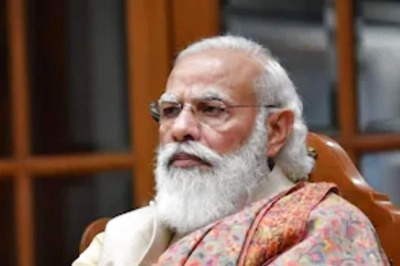
views
London: Wealthy British Sikhs on Thursday wound up plans to bid at a controversial London auction after Sotheby's, the auction house, told them a body armour being put under the hammer did not belong to the 10th Sikh Guru, Gobind Singh.
"It is important that you know that Sotheby's does not consider the Sikh armour plate to be a relic of Guru Gobind Singh, as our cataloguing and estimate clearly indicate," a Sotheby's spokesman said in a statement after Sikhs in India protested.
"I can also tell you we believe that complaints about the proposed offering are based on a misreading of Sotheby's cataloguing, which points to a stylistic similarity to a full set of armour in the possession of the Patiala royal family which the family attributes to Guru Gobind Singh," spokesman Simon Warren added.
Sikh political and religious bodies from Anandpur Sahib to Patna have petitioned Prime Minister Manmohan Singh, held demonstrations, and dashed off letters of protest to the Indian high commission in London and Sotheby's calling for the rectangular 29-by-21-cm-body armour to be returned to Sikhs.
The clarification calmed the nerves of London-based Sikh businessmen and Gurdwaras who had been informally rallying to bid for the object - valued at 10-12,000 pounds - after a heritage website alerted Sikhs about the April 9 auction.
"A few of us were discussing the auction when we got to know that it's not the real thing," said Ajinder Pal Singh Chawla, a veteran member of the Sikh community in London.
Those who made inquiries about the object included Sikh industrialist Kartar Lalwani and a London Gurdwara.
Although it did not actually say the body armour belonged to the 10th Guru, the website - punjabheritage.org - pointed out that the piece being auctioned bears a "staggering similarity" to a set in the possession of the former royal family of Patiala that is said to have belonged to Guru Gobind Singh.
"This Sotheby's piece bears a staggering similarity to that set. The Sotheby's catalogue entry and press release make the tantalising connection to this being a possible second set."
The Sotheby's catalogue says: "The existence of this plate ... points to the possibility that the Guru commissioned more than one such set."
In its statement Wednesday, Sotheby's said it will add the following saleroom note to make things clear: "Sotheby's has undertaken due diligence to verify the provenance of this piece, which is believed to date to the Eighteenth Century. Sotheby's has not found or been given any evidence to indicate ownership of this piece by Guru Gobind Singh and we therefore do not deem the piece to be a relic of the Guru.
"The piece has strong stylistic similarities to a full set of armour in the possession of the Patiala royal family, which according to family lore was attributed to the Guru. The verse inscribed on the armour-plate had been originally composed by Guru Gobind Singh, although it has no necessary or exclusive connection to armour belonging (or attributed) to the Guru."
Chawla, a former businessman who now runs a cancer charity, said: "We Sikhs are quite attached to our heritage objects. If there is something of importance, then everybody will be interested."
A marble bust of Maharaja Duleep Singh - the last Sikh king, who lived out his life in the company of royals in England - was valued at about 30,000 pounds at an auction at Bonham's last year. It went for 1.7 million pounds to a mystery buyer.


















Comments
0 comment